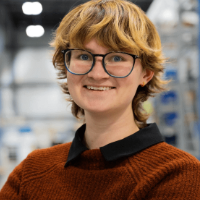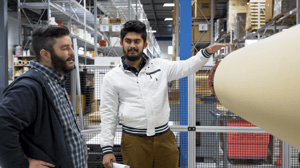It’s easy to become overwhelmed when you’re searching for the right manufacturing method. In the worst of cases, your motivation might gradually dwindle until you’re ready to accept a worse option for an immediate solution.
Luckily, with 37+ years of experience in roll-to-roll manufacturing, we at Strouse feel confident in our ability to provide a brief explanation that will help you make a decision.
Let’s review the definition of roll-to-roll processing and its techniques so you can decide whether it suits your manufacturing goals.
What is Roll-to-Roll Manufacturing?
Roll-to-roll manufacturing (R2R) is the process of converting raw rolls of material into finished products on a roll. This is accomplished on a machine press through die cutting, printing, slitting/winding, adhesive lamination, or coating.
Flexible material converters are responsible for carrying out R2R processes using adhesive tapes and other materials for roll manufacturing.
5 Roll-to-Roll Processing Techniques
Depending on your goals, each material roll will undergo different techniques. Here’s an explanation of how each method benefits you.
1. DIE CUTTING
What happens when you need individual products on a roll? Rotary die cutting is a common roll-to-roll processing technique for cutting material into a given shape.
An operator loads rolls of raw materials onto one side of a machine press. The material then passes through rollers and die cut tools, which cut precise shapes onto the liner or backing and peel away excess material. Afterward, the newly cut material is re-rolled to facilitate easier part application of the freshly cut products.
Die cut parts on a roll are used in assembly line automation and other instances where high product quantities are best distributed from rolls.
2. PRINTING
The R2R printing process is often used to print labels, logos, or other markers onto rolls of material.
There are multiple types of roll-to-roll printing:
- Flexographic printing
- UV printing
- Thermal transfer printing
However, your ideal printing method will ultimately depend on the types of material and ink you use.
3. SLITTING/WINDING
You may not realize it, but flexible materials like tape are often sold in massive logs about 21-60 inches wide. Roll slitting consists of cutting large material rolls into smaller rolls for usability.
Different types of roll slitting services include log slitting and rewind slitting. Your choice will depend on the material you’re using, your project budget, and the tolerances you hope to achieve.
In this context, “winding” refers to the process of re-rolling materials into individual rolls after the machine has slit them.
4. ADHESIVE LAMINATION
Adhesive lamination means running multiple materials together to combine them into a material stack. These material stack-ups can serve as differential double-sided tapes and in other applications.
For instance, roll-to-roll adhesive lamination might involve laminating a PET carrier between acrylic tape and silicone tape to create a differential double-sided acrylic-silicone tape.
5. COATING
Some projects require R2R coating processes like solvent, hot melt, water-based, UV-curable, or plasma coatings. These coatings serve different uses, such as barrier layers or protective coatings to prevent corrosion.
In addition, certain EV battery products may require positive or negative electrode slurry coatings on positive or negative copper foil.
Getting Started with Roll-to-Roll Processing
By now, you’ve probably read enough to decide whether roll-to-roll manufacturing suits your project. So, how do you decide which converter to use?
A lot of it comes down to their manufacturing capabilities. If a converter offers the services you’re looking for with guaranteed quality standards, then they could be a good choice for you.
If you’re interested in contacting a converter about a roll-to-roll solution, reach out to Strouse today for a free consultation. Otherwise, you can learn more about converting in our Learning Center.







